Pilot Briefing: News
Who’s first, Airbus or Cri-Cri?
Electrifying battle above the English Channel
By Thomas A. Horne
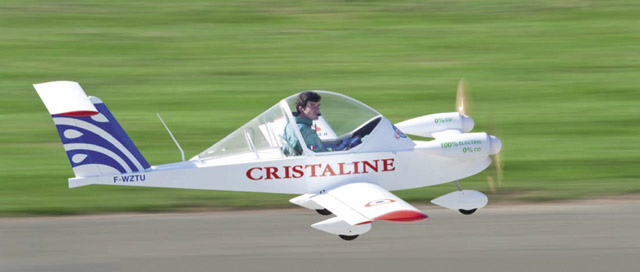
Hugues Duval flies the Cri-Cri E-Cristaline airplane (above); Airbus’ electrically powered E-Fan twin jet (below).
If the goal was publicity, then both organizations claiming to be the first to fly an electric airplane across the English Channel were winners.
Airbus’ electrically powered E-Fan twinjet crossed the English Channel on July 10. Airbus said that the E-Fan was the first electrically powered airplane to make the flight—from Lydd in the United Kingdom to Calais, France. That was later qualified as being the first twin-engine electric aircraft to take off under its own power and cross the Channel. Airbus still claims it is in the record books.
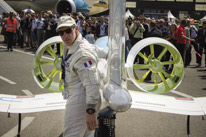 Hugues Duval says he made a Channel crossing the day before—in his Cri-Cri E-Cristaline airplane, powered by twin 15-horsepower Electravia electric motors. Duval said that his flight did not begin with a conventional takeoff. Instead, his Cri-Cri was launched mid-air from a Broussard MH1521, a 1950s French observation and liaison warbird powered by a 450-horsepower Pratt & Whitney R-985 Wasp radial engine. Authorities prevented Duval from taking off from an airport for “administrative reasons,” Duval said. There was no word on whether Duval will alter his claim to be the first air-launched electric airplane to cross the Channel.
Hugues Duval says he made a Channel crossing the day before—in his Cri-Cri E-Cristaline airplane, powered by twin 15-horsepower Electravia electric motors. Duval said that his flight did not begin with a conventional takeoff. Instead, his Cri-Cri was launched mid-air from a Broussard MH1521, a 1950s French observation and liaison warbird powered by a 450-horsepower Pratt & Whitney R-985 Wasp radial engine. Authorities prevented Duval from taking off from an airport for “administrative reasons,” Duval said. There was no word on whether Duval will alter his claim to be the first air-launched electric airplane to cross the Channel.
The Cri-Cri was released from the Broussard at a “quite high” altitude (the Broussard’s ceiling is 14,500 feet) near Kent, England, according to Duval, who asserted that Fédération Aéronautique Internationale, and the Aero-club de France, will grant him recognition as being the first to cross in an electric airplane. Duval also landed in Calais.
Duval said that the launch procedure will carry as much validity as the Wright brothers’ use of a drop-weight catapult did back in 1903. The Wrights’ being catapulted down a launch rail was considered the legitimate start of a flight back then.
Airbus’ achievement has been marred by allegations that it pressured electrical giant Siemens into demanding that Slovenian manufacturer Pipistrel not use its electric motor, citing safety concerns. (Siemens is an E-Fan sponsor, and provides electrical components to Airbus.) Siemens demanded the return of the motor, and banned Pipistrel from using it in the future.
Pipistrel had been planning a cross-Channel flight of its own, using its Alpha Electro two-seat trainer, which is powered by a Siemens 60kW/80-horsepower motor.
The drama has taken on David versus Goliath overtones. Huge conglomerates like Airbus and Siemens are pitted against the tiny Cri-Cri.
Email [email protected]
Kids on their way up
Lakeland students restore Turkish Cub
By Alton K. Marsh
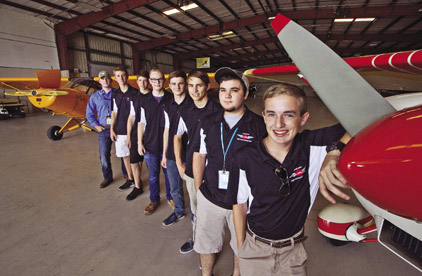 Flight instructor Phillip Herrington (left) with Trevor Penix, Tyson Trentham, Michael Jenkins, Liam Clancy, Donovan Richards, Dane Busone, and Skyler Burnam.
Flight instructor Phillip Herrington (left) with Trevor Penix, Tyson Trentham, Michael Jenkins, Liam Clancy, Donovan Richards, Dane Busone, and Skyler Burnam.
These young folks are going somewhere—Oshkosh, to be exact. Not only are they adding to the aviation industry, pilot population, and registered aircraft count, they are encouraging younger kids along the way.
But wait, there’s more. The Lakeland Aero Club serves as inspiration to other similar groups around the nation, which is why they met Wisconsin teens when they flew themselves, and an airplane they rebuilt, to EAA AirVenture.
The airplane is a Turkish Air Force Piper Cub, military designation L–18C, that never had an FAA airworthiness certificate. To get one, the teens and barely post-teens had to research exactly what a 1953 Cub was like, and scour the nation for proper parts. That airplane—along with a Piper PA–22, a Cessna 140, a Citabria, a Cessna 150D, and a 1966 Cessna 182—took 11 club members to AirVenture. When this was written they were already on their way up to Oshkosh, exalting at the mountains which some had never seen. You can follow “The Lakeland Aero Club” on Facebook. Over the years the club has produced 30 pilots and other aviation professionals.
Along the route they met and helped Boy Scouts in Tennessee get their aviation merit badges and gave Young Eagles flights to kids. Once in Oshkosh they met with Wisconsin youth who are doing similar projects. There was barely time to meet at Oshkosh with AOPA’s Mark Baker that same day, July 22, but they worked it into their busy schedule—as celebrities always do.
Email [email protected]
Photo courtesy Michael Wilson/Lakeland Ledger
Solar Impulse’ damaged on Pacific crossing
Remaining in Hawaii to repair batteries
By Dan Namowitz
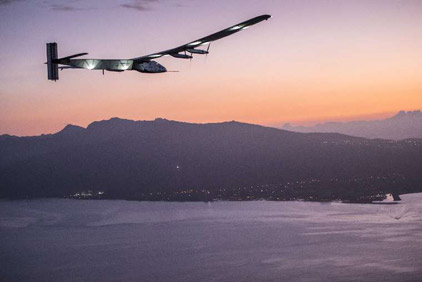 Solar Impulse, an airplane powered only by the sun and 2,000 pounds of batteries, has completed the most difficult leg of a round-the-world flight, but will sit grounded in Hawaii for several months to repair damage caused by battery overheating. The Solar Impulse team said that the second half of the trip would be delayed until April 2016.
Solar Impulse, an airplane powered only by the sun and 2,000 pounds of batteries, has completed the most difficult leg of a round-the-world flight, but will sit grounded in Hawaii for several months to repair damage caused by battery overheating. The Solar Impulse team said that the second half of the trip would be delayed until April 2016.
The uncontrolled increase in battery temperature was caused by overinsulation. The problem had the aircraft’s mission team nervously watching as soon as the aircraft began its climb to 28,000 feet at the start of the five-day-and-night flight leg from Nagoya, Japan, to Hawaii, said Solar Impulse founders and pilots Bertrand Piccard and Andre Borschberg.
“And while the mission team was monitoring this very closely during the mission leg, there was no way to decrease the temperature for the remaining duration of the flight as each daily cycle requires an ascent to 28,000 feet and descent for energy management issues,” they said.
The overheating caused irreversible damage to some battery components, requiring repairs “that will take several weeks to work through,” they said.
During the downtime in Honolulu, Solar Impulse’s engineering team also “is looking at various options for better management of the cooling and heating process for very long flights.”
The so-called zero-fuel airplane launched from Abu Dhabi on March 9 on “the first ever round-the-world solar flight.” It landed in Hawaii on July 3, having accomplished eight legs and 18,000 miles of its mission “to inspire innovation and pioneering spirit and encourage the adoption of clean technologies, renewable energy, and energy efficiency.”
The 117-hour, 52-minute flight leg from Nagoya to Hawaii, flown by Borschberg, established a record for oceanic flight in a solar-powered airplane, the team said.
After repairs, Solar Impulse will head to the U.S. West Coast.
Stats
Total Solar Impulse flight time to Hawaii: 4 days, 21 hours, 52 minutes
Distance: 4,481 statute miles
Maximum height: 28,326 feet
Average speed: 33 knots (38 mph)Email [email protected]
One week to solo now online
Check out the video webisodes that chronicle the One Week Ready to Solo students who stepped out of their day-to-day lives for a one-week adventure at Sun ’n Fun. Three students began the process of learning to fly and the week-long experience was videotaped and cut into a series of webisodes. Join in on the experience and follow their journey online.
Illinois team takes first place in 2015 Air Race Classic
Two pilots representing Southern Illinois University Carbondale (SIUC) took first place in the 2015 Air Race Classic, which concluded on June 25. The all-women’s 2,200-nautical-mile race launched from Fredericksburg, Virginia, and concluded in Fairhope, Alabama.
Stephanie Armstrong and Jessica Reed, flying a Cessna 172R, were first-place finishers among 54 teams. Reed is a senior in aviation management. Armstrong graduated in May 2013 with a degree in aviation management and is an assistant instructor at SIUC. Second place went to the University of North Dakota’s team consisting of Jennifer Pinkowski, Carly Namihira, and Christina Druskin.
The 2016 race launches from Prescott, Arizona, and concludes in Daytona Beach, Florida.
—Jill W. Tallman
Oshkosh 2015
Maybe next year
What happened at AirVenture 2015? News for 2016
By Alton K. Marsh
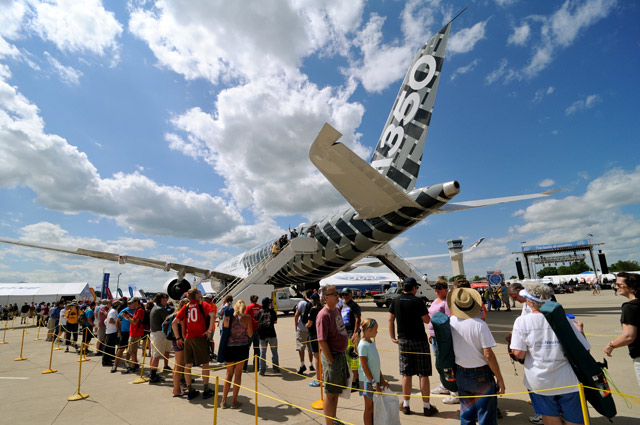
Hundreds line up to tour the Airbus A350WXB (top). The CAF recently saved That’s All Brother, the lead C-47 on D-Day (below left). Massive aircraft in Boeing plaza were on display, such as the B–52 Stratofortress on the flight line (center right). At Tuesday’s Ice cream social, AOPA President Mark Baker talks with members (bottom left).
Want some really big Oshkosh news? For that you’ll need to wait until EAA AirVenture 2016. This year—2015—the news was all about getting ready for big things happening next year, in addition to enough ADS-B products, diesel engine, and avionics connectivity announcements to fill the Sunday New York Times. Suffice it to say that avionics systems from any company now talk to your phone or your tablet. Manufacturers are even talking to each other, as in the case of Garmin systems sharing data with ForeFlight, Jeppesen, and others.
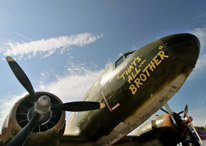
The most unusual news-in-waiting is from Germany’s Rimowa luggage company, which will place an open-cockpit Junkers F13 back into production with a price tag of $2.2 million. It was the corrugated-metal airplane that inspired the design of expensive Rimowa luggage. Built from 1919 to 1932, it has an open cockpit for two pilots, a heated cabin for four passengers, and was used by the United States Navy and United States Postal Service. It could take on a tree and keep its passengers alive. It will fly in March 2016. See the website for more on the 95-knot, 450-horsepower radial-engine aircraft with a 48-foot wingspan.
Other upcoming projects include development of a customer model of the nearly certified Cirrus Aircraft SF50 Vision jet; FAA reciprocal certification of the Tecnam four-place P2010 this fall; the first flight of a restored all-composite 1960s Windecker Eagle at Mooresville, North Carolina, later in the year; and first in-flight tests of a new 135-horsepower Rotax 915 IS engine that will deliver in two years. The Nextant Aerospace G90XTa remanufactured King Air C90 with GE H75-100 engines, might be certified by the FAA in September 2015 or earlier.
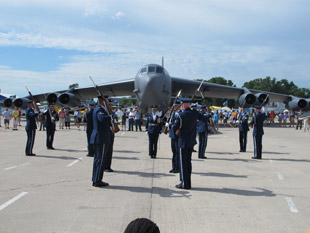
Mooney International expects to build its carbon composite M10 diesel-powered personal and trainer aircraft before the end of 2015. Certification could occur in 2017. Cessna said its diesel Skyhawk will be certified with a Thielert/Technify/Continental CD155 horsepower engine in 2016. Piper has already delivered an Archer DX with the same engine.
Continuing the diesel theme, Continental has received FAA certification for the CD-230 upgrade. The original CD-230 was certified in 2012, and it’s anybody’s guess as to the identity of the secret manufacturer now working with Continental to offer the engine on an airframe next year.
Nobody seems to know much about the future of the Cessna 182 JT-A diesel that racked up an off-field landing and development delays with an SMA engine before Cessna returned to gasoline engines. Say, you don’t suppose Cessna and Continental are talking, do you?
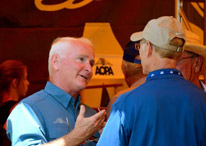
American Legend Cub is going to mount the Gemini diesel engine on an airframe soon. The airframe and engine shown at EA
A AirVenture 2015 were only a mockup. Epic Aircraft says it is “pushing hard” to achieve certification of its $2.95 million Epic E1000 turboprop by early 2016.
That’s the list of news that’s going to happen in the future. Fans of the Icon A5 amphibious Light Sport aircraft will be delighted to know their seven-year wait since first flight is over; the first one was delivered to EAA Young Eagles Chairman Sean D. Tucker, famous for his helicopter-like, no-airspeed maneuver and brain-scrambling routine using his own skin as a pressure suit in a specially built biplane. Kids will get a much calmer Icon ride as their introduction to aviation.
Email [email protected]
For more 2015 EAA AirVenture news, see the website
Photography: Mike Collins, Alyssa Miller
EAA AIRVENTURE 2015
Gate attendance Up 2 percent, according to EAA Chairman Jack Pelton
16,000 Aircraft arrivals
553,000 Through the gates
800 Exhibitors
60 Rusty Pilot attendees
4.3% Increase in camping aircraft
Industry news
Superior Gemini and Weslake diesel engines announced
By Marino Boric
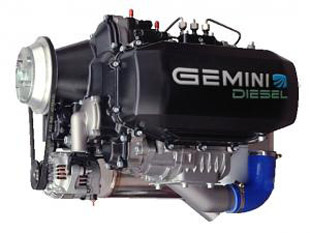 Superior air parts announced its entry into the diesel engine market with the acquisition of the Gemini Diesel engine project earlier this year. This announcement occurred after the British developer Weslake showcased its version of the similar diesel engine at Aero 2015 in Germany. With these engines, Superior and Weslake get into direct competition with engines from the market leader Rotax and its 912 engine range.
Superior air parts announced its entry into the diesel engine market with the acquisition of the Gemini Diesel engine project earlier this year. This announcement occurred after the British developer Weslake showcased its version of the similar diesel engine at Aero 2015 in Germany. With these engines, Superior and Weslake get into direct competition with engines from the market leader Rotax and its 912 engine range.
According to Superior, the three-cylinder, two-stroke diesel with 100 horsepower will be the first brought to the market. The Gemini engine is expected to deliver 100 horsepower from its approximately 1.6-liter displacement. The next step will be the addition of an exhaust-gases driven turbocharger, to be installed in front of the existing volumetric (double-screw type) supercharger. The Gemini 125 engine is expected to deliver 115 to 125 horsepower.
Both two-stroke diesel engines use the self-igniting combustion principle, successfully tested during World War II in German Junkers Jumo 205 engines. The new engines do not have cylinder heads and valves; the pistons—two per cylinder—move in opposite directions in a common cylinder and form the combustion chamber between them. The fuel is injected by a high-pressure, common-rail, electronically controlled fuel injection system. The pistons are connected by connecting rods with two crankshafts located behind the two cylinder ends. Since the two crankshafts are located on the engine perimeter they are connected by means of gear train drives— on the engine’s front side—with the central propeller shaft. The reduction gear of the Gemini engine has a 1:1.6 ratio so that both crankshafts run at 4,000 rpm but the propeller spins at only 2,500 rpm. Weslake and Superior expect to have their engines flying by the end of 2015.
—Marino Boric is an aviation journalist from Germany.
Navy carrier drone refuels
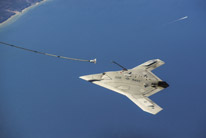 The X–47B drone that has already made unmanned landings and takeoffs from an aircraft carrier has now made an unmanned aerial refueling. The X–47B is a tailless, strike fighter-sized unmanned aircraft developed by Northrop Grumman as part of the U.S. Navy’s Unmanned Combat Air System (UCAS) Carrier Demonstration program. Two aircraft are flying in the test program. The program is currently testing relevant carrier launch, landing, and integration technologies. The Navy has previously tested remotely piloted helicopters at sea. You can see and hear the X–47B refueling on YouTube.
The X–47B drone that has already made unmanned landings and takeoffs from an aircraft carrier has now made an unmanned aerial refueling. The X–47B is a tailless, strike fighter-sized unmanned aircraft developed by Northrop Grumman as part of the U.S. Navy’s Unmanned Combat Air System (UCAS) Carrier Demonstration program. Two aircraft are flying in the test program. The program is currently testing relevant carrier launch, landing, and integration technologies. The Navy has previously tested remotely piloted helicopters at sea. You can see and hear the X–47B refueling on YouTube.
—Alton K. Marsh
This month in aviation
September 25, 1903. The Wright brothers arrive in Kitty Hawk, North Carolina, to prepare for their historic flight.
September 15, 1904. Orville Wright makes the first turn with an airplane. Wilbur makes the first circle five days later.
September 23, 1911. The first air mail in the United States was carried by Eagle Ovington.
September 2, 1916. Airplanes communicate via radio for the first time in flight.
September 24, 1929. James H. Doolittle takes off and lands entirely on instruments in the first blind flight.
September 14, 1939. Igor Sikorsky pilots the first practical helicopter, the VS–300.
September 16, 1947. The U.S. Air Force is established as a separate and equal branch of the U.S. armed forces.
September 15, 1959. A. Scott Crossfield is first to pilot the X–15, the fastest and highest flying aircraft in history.
September 3, 1971. The Concorde makes its first transatlantic crossing.
September 5, 1984. First flight of the Space Shuttle Discovery concludes.
September 26, 1996. Shannon Lucid sets the U.S. record for continuous stay in space and begins a more than two-year continuing U.S. presence in space.
September 22, 2012. First group of USAF UAV operators graduate without learning to be pilots.
September 17, 2013. Boeing 787-9 makes its first test flight.
September 25, 2013. An unmanned F-16 breaks the sound barrier.
Sponsored by Breitling


